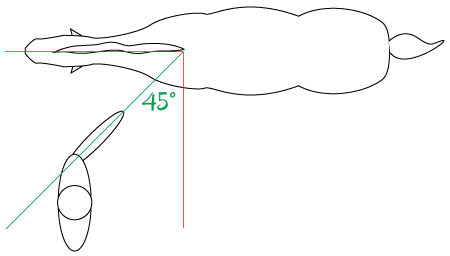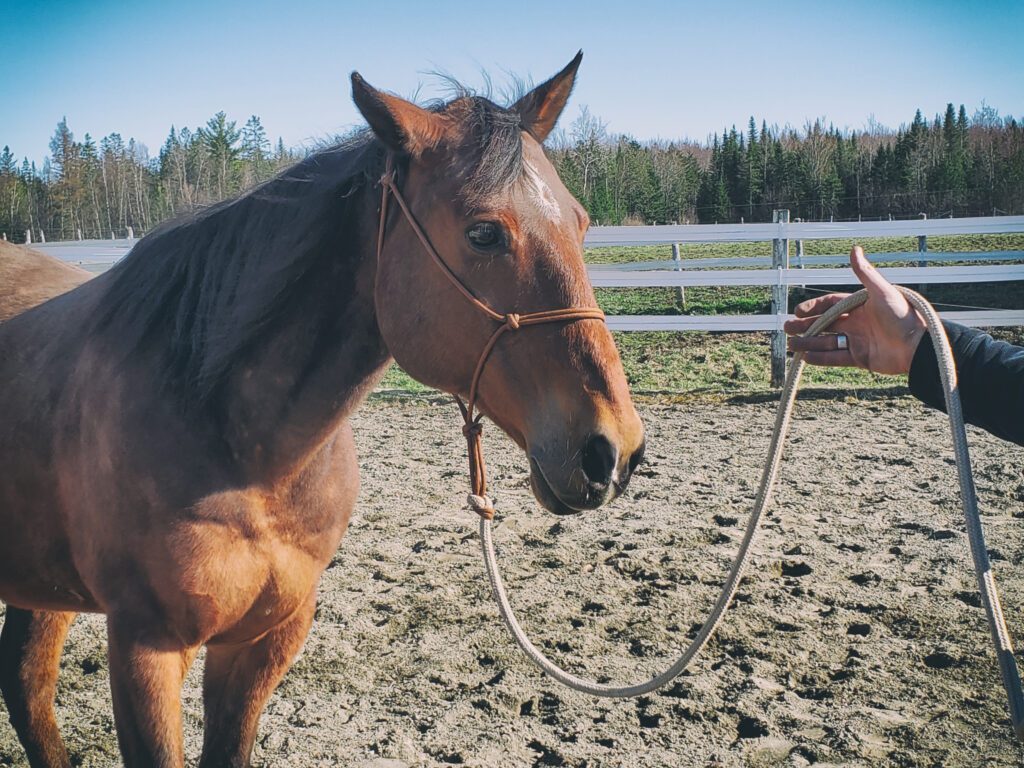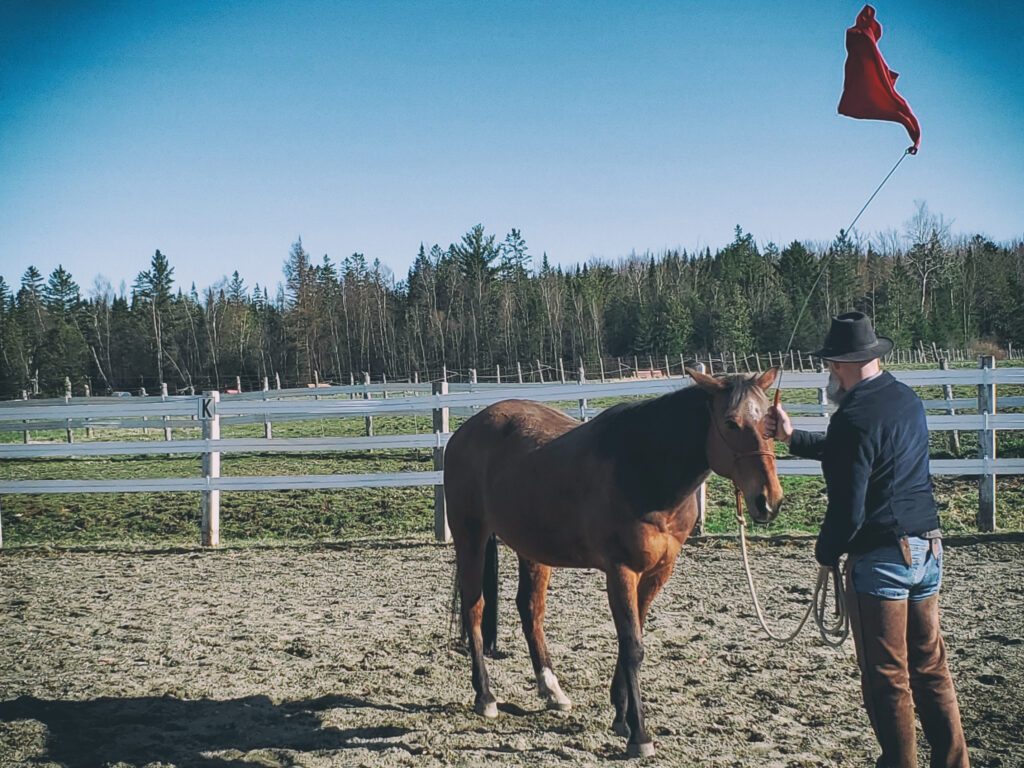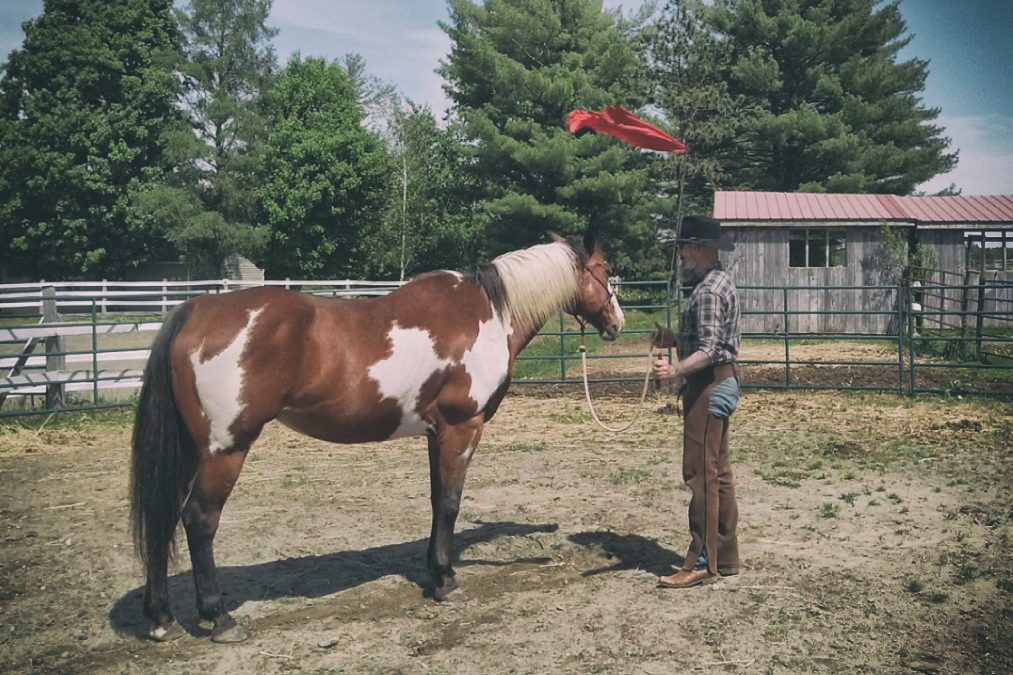Desensitize to the hand, to the lead rope, to the flag, etc. Touch, throw the rope, tap the flag, and carry it over until the horse stands still and relaxed.
Table of Contents
Desensitizing a horse to the flag, to the rope or to the hand is a basic exercise that would actually considerably reduce the number of injuries caused by horses suddenly fleeing because of a plastic bag, a car, wind in branches, etc. The first objective is security.
You should be able to come to your horse without any hesitation, without checking if you do not wear or hold something that might frighten him. You should be able to ride your horse without fear of a sudden side jump because a tarp or something flapped in the wind. You should be able to raise your hand quickly around your horse without him to get stressed and ready to gallop to the other side of the country.
The second objective of desensitizing is to teach your horse that there is no safer, no more comfortable place in the world than close to you. He should feel safe, in good hands, when hanging around you.
Education principles:
1 ) Horses learn when you release pressure.
2 ) Timing is essential to good horsemanship, recognize the signs of relaxation to make sure you release right on time: blinking eyes, lowering the head and neck, chewing mouth, cocking a hind leg.
Position
Position yourself at an angle of 45° to the horse’s shoulder, as far as one good length of your arm. That is the safest place as the horse can not kick you, nor rear and paw you. Hold the rope in your left hand _ if you are on the horse’s left side _ about three feet (one metre) from the fiador knot, hand is up and close to the horse’s head. Then you can protect yourself in case the horse moves the head violently from one side to the other. Hold the flag in the other hand as you would hold a tennis racket, firm but not hard.

Security
Keep the horse’s head tipped slightly inside ALL the time, so the hindquarters are always forced to the outside. If you think the hind end is getting too close to you, just pull on the rope to draw the head, that will push the hindquarters away. You have to look at all the horse’s body, be aware of his head, his front legs, his hind legs, etc. If the horse moves, do the necessary to maintain your position at 45° to his shoulder, so you never end in front of him or worse: behind him.

Process
Wave the flag a couple of metres far from the horse (about 6 to 7 feet), do not be aggressive but make sure you are firm. As soon as the horse stands still and shows he is relaxed, stop waving the flag and pet the horse with your hand. Repeat the desensitizing process closer and closer, around the hindquarters, above the withers, along the neck, etc. Then, do the same from the other side of the horse.
Last, you can face the horse and desensitize under the chin, on both sides of the head and above the poll until he remains relaxed all the time. Along the process, as the horse gets more confident around the flag, you can rub him with the flag instead of your hand, so he gets used to be touched everywhere with objects.

Q&A
What if my horse starts to trot or canter away when desensitizing?
Keep waving the flag around the horse, you may reduce the level of pressure by waving the flag farther from him or slower, but keep walking to the horse, maintain your position and stop only when he stands still and shows any of the above mentioned signs of relaxation.
What if my horse does not show any sign of relaxation?
At the beginning, you may wait for a while before the horse stands still, then a few more minutes until he blinks an eye or lowers the head. Sometimes, he will have difficulties just to stand still, then keep waving for another few seconds when your horse stands still, release pressure and rub him. That is a way to show the horse that he should relax. Start the desensitizing process again and stop this exercise only when the horse shows a sign of relaxation. The day after, he will relax quicker.
What if my horse starts to crowd me or tries to run over me?
The goal of this exercise is to make sure the horse is not afraid of the flag, yet he ought to respect it. So, if your horse starts to run over you, bump firmly _ do not hurt him though _ in the belly with the flag, your security always comes first.
What if my horse starts to back up?
Walk to the horse, waving the flag all the time. You should gently follow your horse all the way around until he stops and shows a sign of relaxation.
What if my horse starts to bend its head toward the flag?
That is a good sign, as if he dares bend the head to smell and recognize the flag, that means he feels a little more comfortable. So, let your horse a few seconds to smell and check the flag, then bring his head back and pet him.
